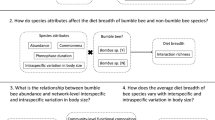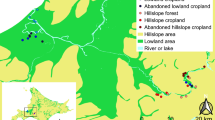Summary
Highly diverse assemblages of nectivorous bee flies (Diptera: bombyliidae) occur at desert sites in California presenting an opportunity to investigate the ecology of this little-known group. This study compared communities of adult bee flies visiting flowers at two sites, one in the Mojave Desert (Darwin Plateau) and one in the Great Basin (Mono Basin), during periods of higher and lower resource abundance. The range of resources used by single species varied inversely with the number of species present, with the greatest number of species and smallest niche breadths occurring at the Darwin Plateau. Adult bee flies did not visit flower resources at random. Rather the two major divisions of the family exhibited contrasting patterns of specialization on plant species. Results of this study support the hypothesis that resources were limiting for adult bee flies in the period of lower food abundance at the Darwin Plateau and not limiting at the Mono Basin during this study. Bee flies at the Mono Basin exhibited lower densities per flower (despite higher densities per unit area), lower frequency of feeding, a lower degree of specialization, and less pronounced phenological changes than bee flies at the Darwin Plateau. The data suggest that episodes of population regulation in the non-parasitic (i.e. adult) stage, due to short supply of the adults' food, contribute to determining the structure of parasitoid communities.
Similar content being viewed by others
References
Adamovic ZR (1966) Ecological differences of some closely related species. Ekologija 1:121–131
Bayo Lawal H, Upton GJG (1980) An approximation to the distribution of the χ 2 goodness-of-fit statistic for use with small expectations. Biometrika 67:447–453
Berger WH, Parker FL (1970) Diversity of planktonic Foraminifera in deep-sea sediments. Science 168:1345–1347
Brown JH, Bowers MA (1983) Patterns and processes in three guilds of terrestrial vertebrates. In Strong DS, Simberloff D, Abele LG (eds) Ecological communities: conceptual issues and the evidence. Princeton Univ Press, Princeton, NJ
Cohen D (1966) Optimizing reproduction in a randomly varying environment. J Theor Biol 12:119–129
Cohen J (1977) Statistical power analysis for the behavioral sciences. Academic Press, N.Y.
Cole FR (1969) The flies of western North America. Univ Calif Press, Berkeley
Connell JH (1978) Diversity in tropical rain forests and coral reefs. Science 199:1302–1310
Cruz A (1974) Feeding assemblages of Jamaican birds. Condor 76:103–107
Dennis DS, Lavigne RJ (1976) Ethology of Efferia varipes with comments on species coexistence (Diptera: Asilidae). J Kansas Ent Soc 49:48–61
Du Merle P (1966) Modele de cage permettant d'obtenir la ponte d'un diptere Bombyliidae, Villa quinquefasciata Wied. AP. Meig. Entomophaga 11:325–330
Du Merle P (1971) Biologie de deux espèces du genre Usia Latrielle (Dipt., Bombyliidae). Ann Soc ent Fr (N.S.) 7:241–259
Fienberg SE (1970) The analysis of multidimensional contingency tables. Ecology 51:419–433
Frick KE (1962) Ecological studies on the alkalai bee, Nomia melanderi, and its bombyliid parasite, Heterostylum robustum, in Washington. Ann Ent Soc Am 55:5–15
Gilbert FS (1981) Foraging ecology of hoverflies: morphology of the mouthparts in relation to feeding on nectar and pollen in some common urban species. Ecological Ent 6:245–262
Hairston NG, Smith FE, Slobodkin LB (1960) Community structure, population control and competition. Amer Natur 94:421–425
Heinrich B (1976) Resource partitioning among eusocial insects: bumblebees. Ecology 57:874–889
Heinrich B, Raven PH (1972) Energetics and pollination ecology. Science 176:597–602
Hull FM (1973) Bee flies of the world. The genera of the family Bombyliidae. Smithsonian Institution Press, Washington D.C.
Hynes HBN (1947) Observations on Systoechus somali (Diptera, Bombyliidae) attacking the eggs of the desert locust Schistocerca gregaria (Førskål) in Somalia. Proc Roy Ent Soc London Series A 22:79–85
Inouye DW (1978) Resource partitioning in bumblebees: experimental studies of foraging behavior. Ecology 59:672–678
Inouye DW (1980) The effect of proboscis and Corolla tube lengths on patterns and rates of flower visitation by bumblebees. Oecologia (Berlin) 45:197
Jacobs J (1974) Quantitative measurement of food selection: a modification of the forage ratio and Ivlev's electivity index. Oecologia 14:413–417
Lawton JH, Strong Jr. DR (1981) Community patterns and competition in folivorous insects. Amer Natur 118:317–338
Leck CF (1972) Seasonal changes in feeding pressures of fruit-and nectar-feeding birds in Panamá. Condor 74:54–60
Leius K (1967) Influence of wild flowers on parasitism of tent caterpillar and codling moth. Can Ent 99:444–446
Levins R (1968) Evolution in changing environments. Princeton University Press, Princeton, NJ
Lewontin RC, Felsenstein J (1965) The robustness of homogeneity tests in 2×N tables. Biometrics 21:19–33
MacArthur RH, Levins R (1967) The limiting similarity, convergence and divergence of coexisting species. Amer Natur 101:377–385
May RM (1975) Patterns of species abundance and diversity. In Cody ML, Diamond JM (eds) Ecology and Evolution of Communities. Harvard Univ Press, Cambridge, Mass
Morse DH (1977) Resource partitioning in bumblebees: the role of behavioral factors. Science 197:678–679
Motten AF, Cambell DR, Alexander PE, Miller HL (1981) Pollination effectiveness of specialist and generalist visitors to a North Carolina population of Claytonia virginica. Ecology 62:1278–1287
Munz PA, Keck DD (1968) A California flora and supplement. Univ Calif Press, Berkeley, CA
Paine RT (1966) Food web complexity and species diversity. Amer Natur 100:65–75
Pianka ER (1966) Latitudinal gradients in species diversity: a review of concepts. Amer Natur 100:33–46
Price PW (1980) Evolutionary biology of parasites. Princeton Univ Press, Princeton, NJ
Quinn JF (1983) Disturbance and diversity in Markov process models of space-limited communities. Quart Rev Biol (in press)
Ranta E, Lundberg H (1980) Resource partitioning in bumblebees: the significance of differences in proboscis length. Oikos 35:298–302
Rogers LE, Lavigne RJ (1972) Asilidae of the Pawnee National Grasslands in northeastern Colorado. Agric Exp Stn Univ of Wyoming-Laramie Sci Monographs 25. 35 pp
Roughgraden JD (1974) Species packing and the competitive function with illustrations from coral reef fish. Theor Pop Biol 5:163–186
Roughgarden JD (1976) Resource partitioning among species: a coevolutionary approach. Theor Pop Biol 9:388–424
Schoener TW (1974a) Resource partitioning in ecological communities. Science 189:27–39
Schoener TW (1974b) Some methods for calculating competition coefficients from resource-utilization spectra. Amer Natur 108:332–340
Schoener TW (1982) The controversy over interspecific competition: American Scientist 70:586–595
Siegal S (1956) Nonparametric statistics for the behavioral sciences. MacGraw Hill Book Co, NY
Simpson EH (1949) Measurement of diversity. Nature 163:688
Smith JNM, Grant PR, Grant BR, Abbott IJ, Abbott LK (1978) Seasonal variation in feeding habits of Darwin's ground finches. Ecology 59:1137–1150
Syme PD (1975) The effects of flowers on the longevity and fecundity of two native parasites of the European pine shoot moth in Ontario. Environ Ent 4:337–346
Syme PD (1977) Observations on the longevity and fecundity of Orgilus obscurator (Hymenoptera: Braconidae) and the effects of certain foods on longevity. Can Ent 109:995–1000
Tabet AB (1974) A phenology study of the Bombyliidae of Deep Canyon. MS Thesis, Univ Calif, Riverside, CA
Terborgh J, Diamond JM (1970) Niche overlap in feeding assemblages of New Guinea birds. The Wilson Bull 82:29–52
Toft CA (1980) Feeding ecology of thirteen syntopic species of anurans in a seasonal tropical environment. Oecologia 45:131–141
Toft CA (1981) Feeding ecology of Panamanian litter anurans: patterns in diet and foraging mode. J Herp 15:139–144
Toft CA, Kimsey LS (1982) Habitat and behavior of selected Apiocera and Rhaphiomidas (Diptera, Apioceridae) and descriptions of immature stages of A. hispida. J Kansas Ent Soc 55:177–186
Toft CA, Trauger DL, Murdy HW (1982) Tests for species interactions: breeding phenology and habitat use in subarctic ducks. Amer Natur 120:596–613
Whittaker RH (1965) Dominance and diversity in land plant communities. Science 147:200–260
Wiens JA (1981) Single-sample surveys of communities: are the revealed patterns real? Amer Natur 117:90–98
Wilbur HM (1980) Complex life cycles. Ann Rev Ecol Syst 11:67–93
Willis EO (1966) Competitive exclusion and birds at fruiting trees in western Colombia. Auk 83:479–480
Wolcott GN (1942) The requirements of parasites for more than hosts. Science 96:317–318
Author information
Authors and Affiliations
Rights and permissions
About this article
Cite this article
Toft, C.A. Community patterns of nectivorous adult parasitoids (Diptera, Bombyliidae) on their resources. Oecologia 57, 200–215 (1983). https://doi.org/10.1007/BF00379582
Received:
Issue Date:
DOI: https://doi.org/10.1007/BF00379582




